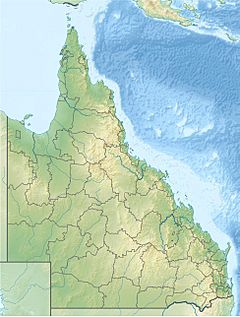Jackey Jackey Creek facts for kids
Quick facts for kids Jackey Jackey |
|
|---|---|
|
Location of Jackey Jackey Creek river mouth in Queensland
|
|
| Other name(s) | Jacky Jacky |
| Country | Australia |
| State | Queensland |
| Region | Far North Queensland |
| Physical characteristics | |
| Main source | Great Dividing Range 49 m (161 ft) |
| River mouth | Kennedy Inlet southwest of Cliffy Point, Torres Strait 0 m (0 ft) 10°55′36″S 142°30′39″E / 10.92667°S 142.51083°E |
| Length | 27 km (17 mi) |
| Basin features | |
| Basin size | 2,963 km2 (1,144 sq mi) |
| Tributaries |
|
| National park | Jardine River National Park |
The Jackey Jackey Creek, also known as Jacky Jacky Creek, is a stream in Far North Queensland, Australia. It flows through the Cape York Peninsula region. This creek is an important part of the local environment and has an interesting history.
Contents
The Creek's Journey
The Jackey Jackey Creek starts its journey in the Great Dividing Range. It flows towards the northeast, following the northern edge of the Jardine River National Park. Eventually, the creek reaches Kennedy Inlet. From there, its waters join Newcastle Bay and then flow into the Torres Strait. The creek is about 27 km (17 mi) long.
What is a Catchment Area?
A catchment area is like a giant bowl where all the rain and water drain into one main river or creek. The Jackey Jackey Creek's catchment covers a huge area of 2,963 square kilometres (1,144 sq mi). This area is home to many different types of plants and animals.
Habitats and Wildlife
A part of the catchment, about 257 square kilometres (99 sq mi), is made up of estuarine wetlands. These are places where fresh river water mixes with salty ocean water.
You can find white silica sand dunes in the southern part of the catchment. These dunes have freshwater lakes on top of them. On the western side, there are savannah woodlands, which are grassy areas with scattered trees.
The Escape River-Kennedy Inlet system is located to the north. This area has Australia's largest mangrove forest. Mangroves are special trees that grow in salty coastal waters. This area is also known for Queensland’s biggest pearl oyster site.
Fishy Friends
The Jackey Jackey Creek is full of life! A total of 31 different kinds of fish live in its waters. Some of these include:
- Glassfish
- Pacific Short-finned Eel
- Kabuna hardyhead
- Treadfin silver biddy
- Mouth almighty
- Concave goby
- Coal grunter
- Barramundi
- Oxeye herring
- Mangrove jack
- Eastern rainbowfish
- Obbe's catfish
- Spotted Blue-eye
- Gulf Saratoga
A Look Back in Time
The land around Jackey Jackey Creek has been home to people for thousands of years. The Unjadi and Ankamuti peoples are the traditional owners of this area.
The creek gets its name from an Aboriginal guide named Jackey Jackey. He helped explorer Edmund Kennedy during his trip through the Cape York area in 1848.
During World War II, in 1942, land near the creek was cleared. An airfield, called Higgins Airfield, was built there. This was done after Japanese air raids on the Horn Island Airfield.


